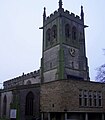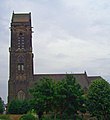Derby: Difference between revisions
No edit summary |
|||
| Line 48: | Line 48: | ||
During the Civil War of 1642–1646, Derby was garrisoned by Parliamentary army commanded by Sir John Gell, who was appointed Governor of Derby in 1643. These troops took part in the defence of nearby [[Nottingham]], the Siege of [[Lichfield]], the Battle of Hopton Heath and many other engagements in [[Nottinghamshire]], [[Staffordshire]] and [[Cheshire]], as well as successfully defending Derbyshire against Royalist armies. | During the Civil War of 1642–1646, Derby was garrisoned by Parliamentary army commanded by Sir John Gell, who was appointed Governor of Derby in 1643. These troops took part in the defence of nearby [[Nottingham]], the Siege of [[Lichfield]], the Battle of Hopton Heath and many other engagements in [[Nottinghamshire]], [[Staffordshire]] and [[Cheshire]], as well as successfully defending Derbyshire against Royalist armies. | ||
[[File:bonniequest.jpg|thumb|Statue of The Pretender on Cathedral Green]] | [[File:bonniequest.jpg|thumb|250px|Statue of The Pretender on Cathedral Green]] | ||
A hundred years later, on 4 December 1745, Charles the Young Pretender ("Bonnie Prince Charlie") set his camp at Derby, on advance south to seize the throne. The prince called at The George Inn on Irongate and demanded billets for his 9,000 men. He stayed at Exeter House, Exeter Street where he held his ''"council of war"''. A replica of the room is on display at Derby Museum in the city centre. | A hundred years later, on 4 December 1745, Charles the Young Pretender ("Bonnie Prince Charlie") set his camp at Derby, on advance south to seize the throne. The prince called at The George Inn on Irongate and demanded billets for his 9,000 men. He stayed at Exeter House, Exeter Street where he held his ''"council of war"''. A replica of the room is on display at Derby Museum in the city centre. | ||
It was here in Derby that Charles received false information that a large army was coming to meet him south of Derby. Although he wished to continue with his quest, he was overruled by his fellow officers. He abandoned his invasion at Swarkestone Bridge on the [[River Trent]] just a few miles south of Derby. As a testament to his belief in his cause, the prince – who on the march from Scotland had walked at the front of the column – made the return journey on horseback at the rear of the bedraggled and tired army. | It was here in Derby that Charles received false information that a large army was coming to meet him south of Derby. Although he wished to continue with his quest, he was overruled by his fellow officers. He abandoned his invasion at [[Swarkestone Bridge]] on the [[River Trent]] just a few miles south of Derby. As a testament to his belief in his cause, the prince – who on the march from Scotland had walked at the front of the column – made the return journey on horseback at the rear of the bedraggled and tired army. | ||
Each year at the beginning of December, the Charles Edward Stuart Society of Derby lead a weekend of activities culminating in a parade through the city centre and a battle on Cathedral Green. | Each year at the beginning of December, the Charles Edward Stuart Society of Derby lead a weekend of activities culminating in a parade through the city centre and a battle on Cathedral Green. | ||
Latest revision as of 08:17, 10 July 2018
| Derby | |
| Derbyshire | |
|---|---|
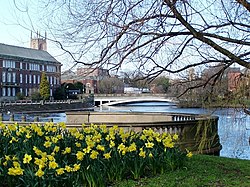 Riverside Gardens, Derby | |
| Location | |
| Grid reference: | SK3533936187 |
| Location: | 52°55’19"N, 1°28’33"W |
| Data | |
| Population: | 236,300 |
| Post town: | Derby |
| Postcode: | DE1, DE3, DE21-24, DE73 |
| Dialling code: | 01332 |
| Local Government | |
| Council: | Derby |
| Parliamentary constituency: |
Derby North, Derby South |
Derby is a city and the county town of Derbyshire. It stands on the banks of the River Derwent in the south of the county. The town centre lies on the west bank of the river but the townscape has long since spread across the bridges and engulfed many of the villages and neighbourhoods all around the town.
Derby became a cathedral town in 1927 when the Diocese of Derby was created and All Saints Church was elevated into a cathedral.[1] City status came to the town in 1977, when the Queen presented the letters patent to the Mayor in person.
The town
In the 2001 census, the population of the city was 233,700, whilst that of the Derby Urban Area was 229,407, making the town one of the largest in the land. As a town, Derby has a great social mixture, combining a fine Georgian and Victorian town centre with vast swathes of industrial and council-built neighbourhoods, affluent neighbourhoods and poor neighbourhoods with social problems. Derby's Victorian growth was created by heavy industry, the decline of which caused great hardship in many parts, but which still industry still continues to be active.
The inner ring road began its slow growth in 1968 when the first sections were built and two new bridges spanned the River Derwent. The route of the ring road went through the St. Alkmund's Church and its Georgian churchyard, the only Georgian square in Derby. Both were demolished to make way for the road, a move still criticised today. Thus the 2nd edition of Pevsner for Derbyshire wrote:- '...the character and cohesion of the centre has been completely altered by the replacement of a large number of C18 houses in the centre by a multi-lane road. As a traffic scheme this road is said to be a triumph; as townscape it is a disaster.' That section of the road is known as "St Alkmund's Way".
The newer buildings along Ford Street and St Alkmund's Way include the Friargate Studios, The Joseph Wright Centre (a campus of Derby College) and the Jurys Inn. The hotel dominates the skyline, demoting nearby St Mary's and, indeed, the Cathedral (silhouettes which formerly described the character of the city). The building of the Jurys Inn has altered well liked approach views of the city such as those from the top of Green Lane, Nottingham Road and from Darley Park.
Name
The name of Derby as such does not appear until the Danish settlement and the ending -by is Danish for "town" or "village", a suffix common in town names in Scandinavia and in the old Danelaw. "Derby" is commonly believed to come from the Old Danish Djúra-bý, recorded in Old English as Deoraby, meaning "animal town" or "deer town".[2] Another theory is that it derives from the name of the River Derwent (which had also given a name to the Roman station of Derventio).
The name of the Derwent is from the Old British tongue apparently meaning "oak-tree water". Derw is Modern Welsh for oak tree.
A number of streets in Derby show Danish influence in their names, such as Irongate and Friargate; "Gate" being Danish for "street", not "gate".
The city emblems
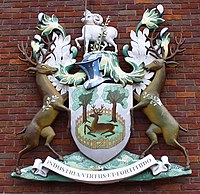
Derby's emblem is the Derby Ram, about which there is a folk song entitled "The Derby Ram". The Ram is found in a number of places, most notably serving as the nickname of Derby County FC. The logo of the City Council's services is a stylized ram, while a ram provided by the Duke of Devonshire is the mascot of the Mercian Regiment formally the Worcestershire and Sherwood Foresters Regiment, deriving from the 95th (Derbyshire) Regiment of Foot.
The arms of the city have the ram as a crest. However the shield itself shows another local symbol, known as "the Buck in the Park". This, a buck seated within an enclosure, is a play on the name of the city, as "Deer-by".
History
Origins
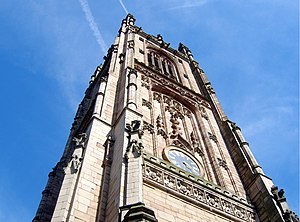
The city has Roman, Anglo-Saxon and Danish origins.
The Roman camp of Derventio was probably at Little Chester or Chester Green north of the city centre. In the early Anglo-Saxon period Derby became a capital of the Mercian kingdom known as Norþworþig, "northern place", along with Tameworþig (Tamworth). In the ninth century Mercia was overrun by the Danes and the town became a Danish stronghold. In 917 in the reign of Edward the Elder, Æþelflæd, Lady of the Mercians and King Alfred's daughter, took Derby (by then known as Deoraby) by storm[3] and four of her thanes died in the town gate. In later years the Norwegians of Northumbria rebelled against King Edmund and took Derby, which was noted as one of the 'Five Boroughs' (fortified towns) of the Danelaw. Edmund liberated the town once again and subdued the Norse.
16th century – 18th century
During the Civil War of 1642–1646, Derby was garrisoned by Parliamentary army commanded by Sir John Gell, who was appointed Governor of Derby in 1643. These troops took part in the defence of nearby Nottingham, the Siege of Lichfield, the Battle of Hopton Heath and many other engagements in Nottinghamshire, Staffordshire and Cheshire, as well as successfully defending Derbyshire against Royalist armies.
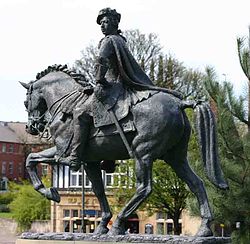
A hundred years later, on 4 December 1745, Charles the Young Pretender ("Bonnie Prince Charlie") set his camp at Derby, on advance south to seize the throne. The prince called at The George Inn on Irongate and demanded billets for his 9,000 men. He stayed at Exeter House, Exeter Street where he held his "council of war". A replica of the room is on display at Derby Museum in the city centre.
It was here in Derby that Charles received false information that a large army was coming to meet him south of Derby. Although he wished to continue with his quest, he was overruled by his fellow officers. He abandoned his invasion at Swarkestone Bridge on the River Trent just a few miles south of Derby. As a testament to his belief in his cause, the prince – who on the march from Scotland had walked at the front of the column – made the return journey on horseback at the rear of the bedraggled and tired army.
Each year at the beginning of December, the Charles Edward Stuart Society of Derby lead a weekend of activities culminating in a parade through the city centre and a battle on Cathedral Green.
Industrial Revolution
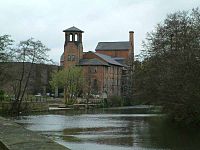
Derbyshire was a centre of Britain's Industrial Revolution. In 1717, Derby was the site of the first water powered silk mill in Britain, built by John Lombe and George Sorocold, after Lombe had reputedly stolen the secrets of silk-throwing from Piedmont in Italy.
In 1759, Jedediah Strutt patented and built a machine called the Derby Rib Attachment that revolutionised the manufacture of hose. This attachment was used on the Rev Lee's Framework Knitting Machine, the stocking frame. Strutt's attachmen was placed in front of the stocking frame and worked in unison with it to produce ribbed hose (stockings). The partners were Jedediah Strutt, William Woollatt (who had been joined in 1758 by John Bloodworth and Thomas Stafford, all leading hosiers in Derby). The patent was obtained in January 1759. After three years, Bloodworth and Stafford were paid off, and Samuel Need – a hosier of Nottingham – joined the partnership. The firm was known as Need, Strutt and Woollatt. The patent expired in 1773, though the partnership continued until 1781 when Need died.
Messrs. Wright, the bankers of Nottingham, recommended that Richard Arkwright apply to Strutt and Need for finance for his cotton spinning mill. The first mill opened in Nottingham in 1770 and was driven by horses. In 1771 Richard Arkwright, Samuel Need and Jedediah Strutt built the world's first water-powered cotton spinning mill at Cromford in Derbyshire, developing a form of power that was to enable the great advances of the Industrial Revolution.
Later came Jedediah Strutt's cotton spinning mills at Belper.
Dr Johnson, the creator of the English dictionary, married Elizabeth Porter at St Werburgh's Church in Derby in 1735. The painter famously known as Joseph Wright of Derby was revolutionary in his use of light in his paintings and was an associate of the Royal Academy, and others ceated new ideas and technicques I many fields in Derby.
The beginning of the nineteenth century saw Derby emerging as an engineering centre with manufacturers such as James Fox, who exported machine tools to Russia.
In 1840, the North Midland Railway set up its works in Derby and, when it merged with the Midland Counties Railway and the Birmingham and Derby Junction Railway, to form the Midland Railway, Derby became its headquarters.
20th century to present day
Derby was awarded city status on 7 June 1977 by Queen Elizabeth II to mark the 25th anniversary of her ascension to the throne.[4] The Queen presented the "charter scroll" or 'letters patent' in person on 28 July 1977 on the steps of the Council House to the then Mayor, Councillor Jeffrey Tillet.[5] Until then, Derby had been one of the few towns in Britain with a cathedral but without city status.
Despite its strategic industries (rail and aero-engine), Derby suffered comparatively little damage in both world wars (contrast Bristol and Filton). This may in part have been due to the jamming of the German radio-beam navigations systems (X-Verfahren and Knickebein, camouflage and decoy techniques ('Starfish sites') were built, mainly south of the town, e.g. out in fields near Foremark (ref. Kirk, Felix & Bartnik, 2002, see talk; see also[6]).
Industry
Derby's two biggest employers, Rolls-Royce plc and the Toyota Motor Corporation are in engineering manufacturing. Egg Banking plc, the Internet and telephone bank, has its national base in Derby. Other companies of note include Railway systems engineering firm Bombardier Transportation who manufacture railway rolling stock at the Derby Carriage and Wagon Works, and Alstom who manufacture large power plant boilers and heat exchangers.
Derby was for many years a railway centre, being the former headquarters of the Midland Railway, with both British Rail workshops and research facilities in the town. Although much less important than in years gone by, train manufacture continues in Derby and Derby railway station retains an important position in the railway network. The city is favoured as a site for a national railway centre.[7]
From 1922 Sinfin Lane was the home of the 62 acre site of International Combustion, originally manufacturers of machinery for the automatic delivery of pulverized fuel to furnaces and boilers, and later producing steam-generating boilers for use in electrical generating plant such as used in power stations. In the 1990s the firm was bought by Rolls-Royce plc and then sold on again to ABB Group.[8]
Derby was the home of Core Design, who developed the computer game Tomb Raider with its heroine Lara Croft, part of the newly opened inner ring road is named Lara Croft Way in recognition of this.
Sights of the city
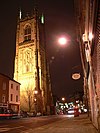
Derby Cathedral tower is 212 feet tall to the tip of the pinnacles. This has been home to a pair of breeding peregrine falcons since 2006.[9] Three webcams monitor the falcons here.[10]
Derby Gaol is a visitor attraction based in the dungeons of the Derbyshire County Gaol which dates back to 1756.
Derby Industrial Museum at the Silk Mill shows the industrial heritage and technological achievement of Derby, including Rolls-Royce aero engines, railways, mining, quarrying and foundries.
File:Pickford expo.jpg|thumb|Pickford's House Museum Pickford's House Museum was built by architect Joseph Pickford in 1770. It was his home and business headquarters.
Derby Museum and Art Gallery has paintings by Joseph Wright of Derby, fine Royal Crown Derby porcelain, natural history, local regiments and archaeology. Pickford also designed St Helen's House in King Street.
Places of interest
- Cathedral Quarter
- Darley Abbey
- Derby Arboretum
- Derby Canal
- Derby Cathedral
- Derby Industrial Museum (Silk Mill)
- St Mary's Church, Derby
- Derby Friargate Station (of which all that remains is Handyside's bridge across Friargate)
 Markeaton Park Light Railway, a heritage railway
Markeaton Park Light Railway, a heritage railway- Pride Park Stadium (Derby County FC)
- River Derwent, Derbyshire|River Derwent
- St Helen's House, Derby
Recreation
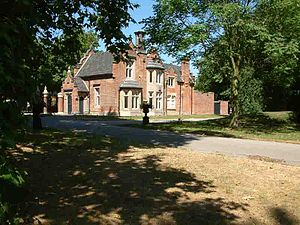
Derby Arboretum was the first public park in the country and inspired similar public parks across the land. It suffered from neglect in the 1990s and gained a bad repultation, but it has since been renovated.
Markeaton Park is Derby's most used leisure facility.[11] It is the venue for the city council's annual Guy Fawkes Night firework display and contains its own light railway.
Other major parks in the city include Allestree Park, Darley Park, Chaddesden Park, Alvaston Park, Normanton Park and Osmaston Park.
Derby has a number of public parks, many Victorian in origin. Darley and Derwent parks lie immediately north of the city centre and are home to owls, kingfishers and other wildlife. Derby Rowing Club and Derwent Rowing Club are located on the banks of the river. There is also a riverside walk and cycle path from Darley Park south to two other parks. West of the city centre is Markeaton Park, while to the north is Allestree Park and its lake.
Derby has the first public recreational park in the country to have an arboretum (Derby Arboretum), which lies to the south of the city centre. The arboretum was set up by the philanthropic landowner and industrialist Joseph Strutt in 1840. The arboretum's website claims that the arboretum's design was the inspiration for the vision of great urban parks in the United States of America.[12]
The city has four museums: Derby Museum and Art Gallery, Pickford's House Museum, The Silk Mill (Derby Industrial Museum) and The Royal Crown Derby Museum.
Shopping and nightlife
Shopping in Derby is divided into two main areas. The first is the Westfield Shopping Centre, controlled by the Westfield Group. The second is the older section known as the Cathedral Quarter. This area includes a range of boutiques and coffee shops and is focused around the cathedral and the area around Irongate and Sadler Gate.
The Friar Gate area contains clubs and bars, making it the centre of Derby's nightlife. Derby is also well provided with pubs.
Picture gallery
-
The cathedral from Green Lane
-
St Peters Mediæval Church showing recent extensions
-
Part of the Rolls-Royce Works
-
St Matthew's, Darley Abbey
-
St Mary's-on-the-Bridge
-
St Luke's, Stockbrook Street
-
The Falstaff public house, Normanton
-
St John's, Bridge Street
-
Part of the Westfield Centre
-
Bust of Steve Bloomer at Pride Park Stadium
-
Derby Cathedral and the Dolphin Inn
-
Friar Gate Studios, Ford Street
-
Derby DRI stained glass window at St Peters
Outside links
| ("Wikimedia Commons" has material about Derby) |
References
- ↑ The Diocese of Derby – History
- ↑ Local Histories: Derby - Tim Lambert: "The name Derby is derived from the Danish words deor by meaning deer settlement"
- ↑ Anglo-Saxon Chronicle (Peterborough Chronicle), 917
- ↑ London Gazette, issue=47246, 14 June 1977
- ↑ The Times. July 29, 1977
- ↑ "Stories". Youandyesterday.co.uk. 1942-07-27. http://www.youandyesterday.co.uk/articles/WWII:_How_film_sets_saved_Derby_at_war. Retrieved 2010-07-17.
- ↑ [1]
- ↑ International Combustion Ltd from American roots to Sinfin Lane at bygonederbyshire.co.uk
- ↑ "Peregrine Project". Derby Council website. http://www.derby.gov.uk/LeisureCulture/MuseumsGalleries/EnvironmentalProjects/PeregrineProject.htm. Retrieved 2008-02-04.
- ↑ "Derby Peregrine Webcam". Derby Council website. http://www.derby.gov.uk/dccwebdev/museum/peregrine/webcam.htm. Retrieved 2010-10-14.
- ↑ Markeaton Today BBC.co.uk
- ↑ "Arboretum history". Christopher Harris. 2010. http://www.derbyarboretum.co.uk/about_the_arboretum.htm. Retrieved 2010-09-19.
| Cities in the United Kingdom |
|---|
|
Aberdeen • Armagh • Bangor (Caernarfonshire) • Bangor (County Down) • Bath • Belfast • Birmingham • Bradford • Brighton and Hove • Bristol • Cambridge • Canterbury • Cardiff • Carlisle • Chelmsford • Chester • Chichester • Colchester • Coventry • Derby • Doncaster • Dundee • Dunfermline • Durham • Ely • Edinburgh • Exeter • Glasgow • Gloucester • Hereford • Inverness • Kingston upon Hull • Lancaster • Leeds • Leicester • Lichfield • Lincoln • Lisburn • Liverpool • City of London • Londonderry • Manchester • Milton Keynes • Newcastle upon Tyne • Newport • Newry • Norwich • Nottingham • Oxford • Perth • Peterborough • Plymouth • Portsmouth • Preston • Ripon • Rochester • Salford • Salisbury • Sheffield • Southampton • St Albans • St Asaph • St David's • Southend-on-Sea • Stirling • Stoke-on-Trent • Sunderland • Swansea • Truro • Wakefield • Wells • Westminster • Winchester • Wolverhampton • Worcester • Wrexham • York |

